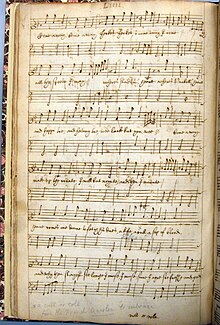Cultural references to Macbeth
[24] William Reilly's 1991 Men of Respect, another film to set the Macbeth story among gangsters, has been praised for its accuracy in depicting Mafia rituals, said to be more authentic than those in The Godfather or GoodFellas.However the film failed to please audiences or critics: Leonard Maltin found it "pretentious" and "unintentionally comic" and Daniel Rosenthal describes it as "providing the most risible chunks of modernised Shakespeare in screen history."[25] In 1992 S4C produced a cel-animated Macbeth for the series Shakespeare: The Animated Tales,[26] and in 1997 Jeremy Freeston directed Jason Connery and Helen Baxendale in a low budget, fairly full-text, version.Christopher Walken plays vegetarian detective Ernie McDuff who (in the words of Daniel Rosenthal) "[applies] his uniquely offbeat menacing delivery to innocuous lines.[32] Vishal Bhardwaj's 2003 Maqbool, filmed in Hindi and Urdu and set in the Mumbai underworld, was produced in the Bollywood tradition, but heavily influenced by Macbeth, by Francis Ford Coppola's 1972 The Godfather and by Luc Besson's 1994 Léon.[35] In spite of the high level of violence and nudity (Macbeth has sex with the three naked schoolgirl witches as they prophesy his fate), intended to appeal to the young audiences that had flocked to Romeo + Juliet, the film flopped at the box office.[36] The 2011 short film Born Villain, directed by Shia LaBeouf and starring Marilyn Manson, was inspired by Macbeth and features multiple scenes where characters quote from it.[38] Directed by Vinícius Coimbra and starred by Gabriel Braga Nunes and Ana Paula Arósio, the film uses a modern-day setting, replacing the throne of Scotland with the presidency of a high-ranked bank.Other unabridged recorded productions have been released by the Marlowe Society (Argo Records ZPR 201-3), the Old Vic Company (HMV ALP 1176) with Alec Guinness and Pamela Brown, and the Complete Arkangel Shakespeare with Hugh Ross and Harriet Walter The extant version of Macbeth, in the First Folio, contains dancing and music, including the song "Come Away Hecate" which exists in two collections of lute music (both c.1630, one of them being Drexel 4175) arranged by Robert Johnson.While Wootton's extended visualization was ultimately more significant, Zuccarelli's allegorical version became available to a much wider constituency, through its 1767 exhibition with the Society of Artists and its subsequent engraving by William Woollett in 1770.

Ellen Terry as Lady MacbethJohn Singer SargentMacbethWilliam ShakespeareWale OgunyemiYorubaEugène IonescoMacbettJoe de GraftMaurice BaringShakespeare's companySleep No Moreimmersive theaterAlfred HitchcockPaisley witch trialsWelcome MsomiUmabathaThe IndependentDev VirahsawmyCreoleMauritianMacbeth on screenJoe MacBethKen HughesMen of RespectMaqboolVishal BhardwajGeoffrey WrightAkira KurosawaKumunosu-jojidai-gekiNoh theatreIsuzu YamadaKabuki TheatreToshiro MifuneThe GodfatherGoodFellasJason ConneryHelen BaxendaleScotland, PAAlexander AbelaMakibefoFaux CapSangradorBilly MorrissetteJames LeGrosMaura TierneyChristopher WalkenBBC TelevisionShakespeaRe-ToldBollywoodFrancis Ford CoppolaLuc BessonIrfan KhanPankaj KapoorSam WorthingtonVictoria HillRomeo + JulietBorn VillainShia LaBeoufMarilyn MansonClassic AliceKate HackettThane of East CountyMontreal World Film FestivalGabriel Braga NunesAna Paula ArósioMalayalam-languageVeeramJayarajDileesh PothanBengaliMandaarAnirban BhattacharyaSohini SarkarNikolay LeskovLady Macbeth of the Mtsensk Districtan operaShostakovichMarvin KayeNgaio MarshLight ThickensJames ThurberSupermanTerry PratchettDiscworldWyrd SistersGranny WeatherwaxJo NesbøHogarth ShakespeareAgatha ChristieBy the Pricking of My ThumbsBirnam WoodRobert JohnsonDrexel 4175The TempestBBC RadioDavid TennantCharles LaughtonLeslie BanksHoward Marion-CrawfordMichael HordernPaul ScofieldJoss AcklandDenis QuilleyIan HolmTim McInnernySteven BerkoffKen StottNeil DudgeonAnthony QuayleGwen Ffrangcon-DaviesCaedmon RecordsMarlowe SocietyArgo RecordsOld Vic CompanyAlec GuinnessPamela BrownComplete Arkangel ShakespeareHugh RossHarriet WalterFirst FolioWilliam BoyceDavenantGarrickGiuseppe Verdi